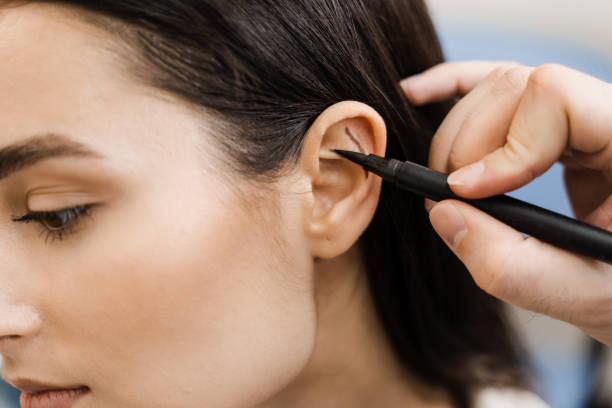Children with prominent, misshapen, or asymmetrical ears often face emotional challenges, including teasing and self-consciousness. Cosmetic procedures like Ear surgery in Islamabad, also known as pediatric otoplasty, provide an effective solution for correcting such ear deformities. Parents considering this option for their children should understand the available surgical methods, benefits, and safety considerations. Pediatric ear surgery not only enhances appearance but also helps children feel more confident in social interactions.
Understanding Pediatric Ear Surgery
Pediatric ear surgery, or otoplasty, is a cosmetic procedure designed for children whose ears have developed abnormally. By the age of 5 or 6, a child’s ears are usually fully developed, making this an ideal time for corrective surgery. Common issues addressed include:
- Protruding or prominent ears.
- Large ear size disproportionate to the head.
- Congenital deformities (such as lop ear or cup ear).
- Asymmetry caused by birth defects or injuries.
This surgery reshapes the ear cartilage to achieve a natural and balanced appearance.
Why Consider Ear Surgery for Children?
Parents often choose pediatric ear surgery for their children for both cosmetic and psychological reasons. The most common benefits include:
- Boosting Self-Confidence: Children are less likely to face bullying or embarrassment.
- Early Correction: Performing the surgery at a young age prevents emotional distress in school years.
- Permanent Results: Once corrected, ear reshaping provides lasting improvements.
- Improved Facial Harmony: Balanced ears make the child’s overall facial appearance more proportional.
Pediatric Ear Surgery Options in Islamabad
There are different surgical approaches available for correcting ear deformities in children:
1. Traditional Otoplasty
This is the most common method, involving small incisions behind the ear. The surgeon reshapes or repositions the ear cartilage to reduce prominence and create symmetry.
2. Cartilage Sparing Technique
In this minimally invasive option, sutures are used to reshape the ear without removing cartilage. It offers natural results with shorter recovery time.
3. Incisionless Otoplasty
A relatively new technique, incisionless otoplasty corrects protruding ears using external sutures. This method reduces scarring and is often suitable for mild deformities.
4. Corrective Surgery for Congenital Defects
Children born with severe ear malformations, such as microtia (underdeveloped ears), may require reconstructive surgery. This involves using grafts or implants to rebuild the ear.
5. Revision Otoplasty
If an earlier procedure did not achieve the desired results, revision otoplasty may be performed to improve appearance and symmetry.
Preparing Children for Ear Surgery
Parents should prepare their children both physically and emotionally for surgery. Key steps include:
- Medical Assessment: A thorough check-up ensures the child is healthy enough for anesthesia and surgery.
- Explaining the Process: Helping children understand the surgery reduces anxiety.
- Lifestyle Adjustments: Avoiding medications or habits that increase surgical risks.
- Pre-Surgery Instructions: Following dietary and activity guidelines given by the surgeon.
Safety and Risks of Pediatric Ear Surgery
Although ear surgery for children is generally safe, some risks include:
- Infection: Rare but treatable with antibiotics.
- Scarring: Minimal, since incisions are usually made behind the ears.
- Asymmetry: Slight differences may occur between the ears.
- Temporary Numbness: Some children experience reduced sensation around the ear area for a short period.
Choosing a qualified surgeon reduces the likelihood of these complications.
Recovery Process for Children
The recovery process after pediatric ear surgery is relatively smooth when parents follow the surgeon’s guidelines:
- Bandages: A protective bandage is applied around the head for the first few days.
- Headband Use: Children are often required to wear a soft headband at night for several weeks.
- Pain Management: Mild discomfort is common but manageable with prescribed medications.
- School Activities: Most children can return to school within a week, but sports and physical activities should be avoided for at least a month.
- Follow-Up Visits: Regular check-ups ensure proper healing.
Psychological Benefits for Children
Correcting ear deformities early in life provides significant emotional advantages. Children often show:
- Increased self-esteem.
- Better participation in school and social activities.
- Reduced anxiety and self-consciousness.
- Long-term positive self-image.
By addressing the issue in childhood, parents can prevent years of emotional distress.
Choosing the Right Surgeon for Pediatric Otoplasty
Parents should be very selective when choosing a clinic or surgeon for their child’s ear surgery. Important factors to consider:
- Experience in Pediatric Surgery: Not all cosmetic surgeons specialize in children.
- Board Certification: Ensures the surgeon meets safety and professional standards.
- Advanced Facilities: A well-equipped clinic reduces risks and ensures safe recovery.
- Before-and-After Cases: Reviewing past cases helps in setting realistic expectations.
FAQs: Pediatric Ear Surgery in Islamabad
1. At what age can a child undergo ear surgery?
The ideal age is 5 to 6 years, once the ears are fully developed.
2. Is the surgery painful for children?
Discomfort is mild and temporary, easily managed with medication.
3. Are results permanent?
Yes, once corrected, the results of pediatric otoplasty are usually permanent.
4. How long does recovery take?
Most children recover within 1–2 weeks, but complete healing may take several months.
5. Is it safe for children?
Yes, when performed by experienced surgeons, pediatric ear surgery is safe and effective.
Conclusion
Pediatric otoplasty offers an effective solution for children with prominent, asymmetrical, or misshapen ears. By addressing the issue early, parents can help their children build confidence and avoid long-term psychological distress. With options like traditional otoplasty, cartilage-sparing methods, and incisionless techniques, families in Islamabad have access to advanced solutions tailored to each child’s needs.





Comments